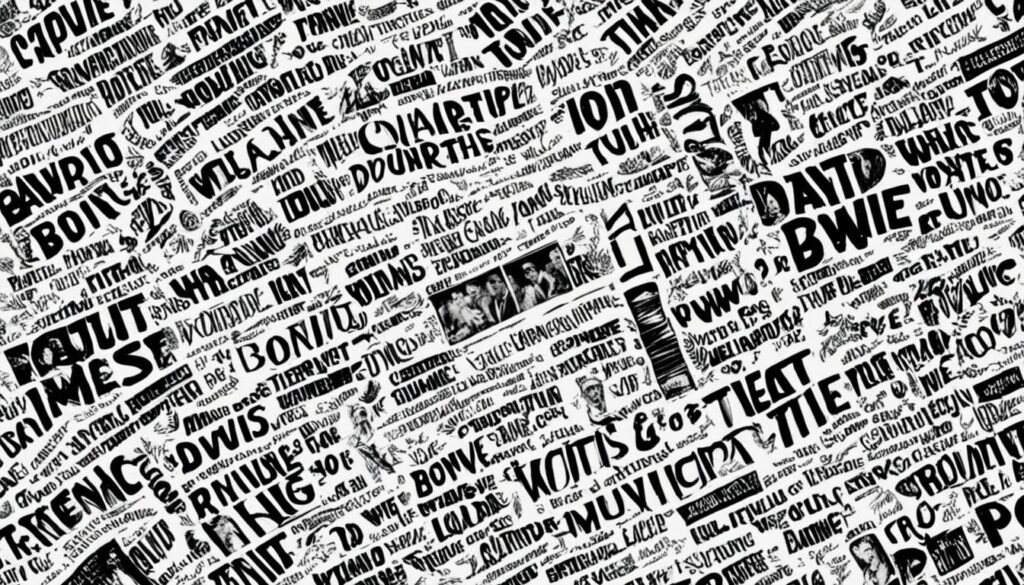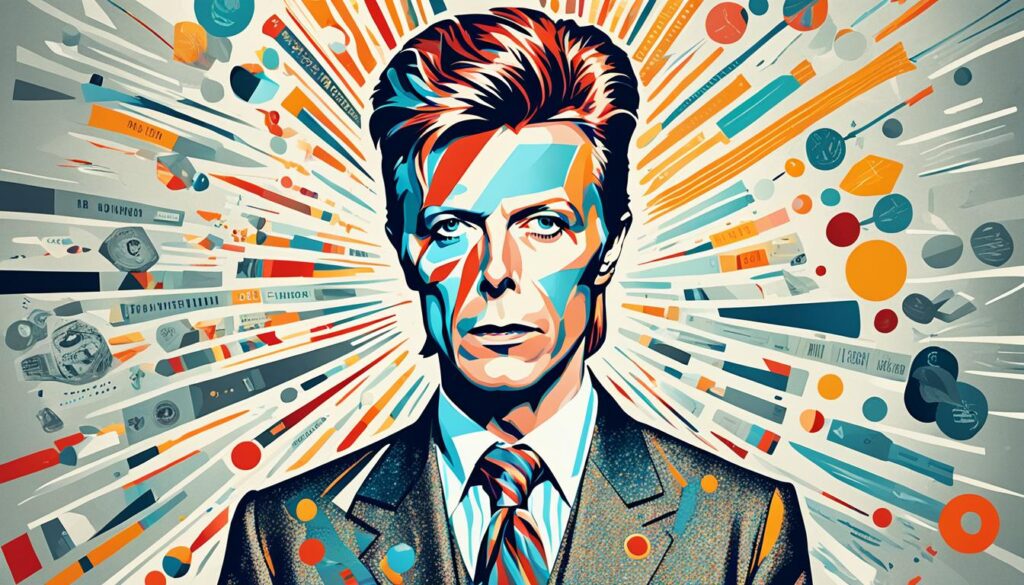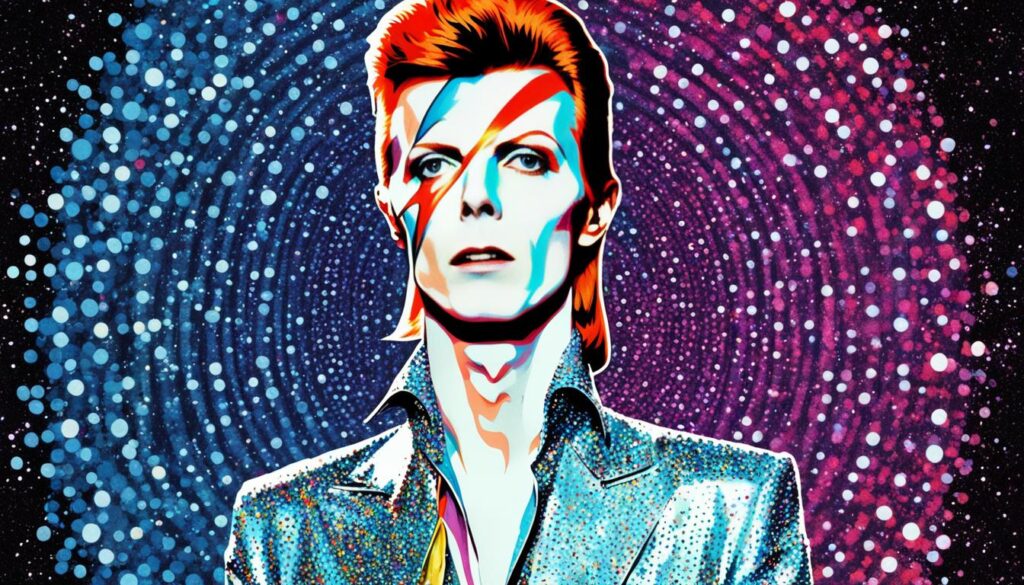When the iconic David Bowie passed away in 2016, he left more than just a musical legacy; he left a financial blueprint that challenges our perceptions of an artist’s worth. With a staggering david bowie net worth at death estimated at $230 million, the question arises: How did the Starman’s forward-thinking approach to art and assets secure such an impressive music icon life earnings? This deep dive into the david bowie final net worth implications reveals the strategic moves behind the monetary worth of a cultural trailblazer.

Key Takeaways
- Understand the composite elements that contributed to David Bowie’s net worth at the time of his death.
- Explore how David Bowie’s innovative financial decisions positioned his estate for substantial growth posthumously.
- Recognize the lasting impact of Bowie’s music catalog in the valuation of his lifelong earnings.
- Investigate how the sale of his music rights became a pivotal moment in the legacy of music monetization.
- Gain insight into the significance of Bowie’s foresight in the context of contemporary music and estate planning.
Exploring David Bowie’s Iconic Legacy and Financial Success
The world knew David Bowie as a daring music icon and an innovator, but his astuteness in financial matters was equally remarkable. From his early days in the industry to his posthumous wealth, Bowie’s financial acumen has been an essential component in shaping his enduring legacy and securing his title as a music icon whose financial success continues to be analyzed and admired.
The Catalysts of David Bowie’s Financial Empire
Calculating David Bowie’s posthumous wealth involves looking back at the moments that laid the foundation for his financial empire. His creative prowess ventured beyond music, pioneering novel concepts like the Bowie Bonds, which became a groundbreaking financial strategy that other artists would soon emulate. His ability to exploit the revenue-generating potential of his art set a new standard for musicians and entertainers of the future.
A Retreat into Bowie’s Innovative Career Milestones
Bowie’s career milestones were not just artistic triumphs but stepping stones to greater financial heights. His influential alter ego, Ziggy Stardust, not only established him as a cultural behemoth but also immensely elevated his marketability and broader appeal across the globe. Every new persona and album translated into a wider audience, more sales, and a larger impact on the worldwide cultural economy.
Monetary Influence: Record Sales and Touring Highlights
It’s undeniable that David Bowie’s record sales and tours have had a resounding impact on his estate’s value. His concerts were more than just live music events; they were cultural happenings that drew huge crowds and significant revenue. Below is a tabulated overview that showcases the substantial financial results from record sales and touring during his illustrious career.
| Album | Release Year | Sales (in millions) | Tour | Year | Revenue (in millions) |
|---|---|---|---|---|---|
| The Rise and Fall of Ziggy Stardust and the Spiders from Mars | 1972 | 7.5 | Ziggy Stardust Tour | 1972-1973 | Est. 2 |
| Let’s Dance | 1983 | 10.7 | Serious Moonlight Tour | 1983 | Est. 5 |
| Black Tie White Noise | 1993 | 1.5 | Sound+Vision Tour | 1990 | Est. 55 |
Bowie’s financial success is a testament to his visionary approach to music and business alike, and his legacy continues to thrive, guiding future generations in the art of balancing creative genius with shrewd commerce.
David Bowie Net Worth at Death: A Comprehensive Review
The world not only lost a music icon and pioneering artist with the passing of David Bowie in 2016, but also witnessed the grand finale of a financial saga as captivating as his records. David Bowie’s net worth at death was a testament to his enduring influence and the astute management of his career, which resulted in significant music icon net earnings at time of passing. With an illustrious career that spanned multiple decades, Bowie’s artistic ventures and savvy investments accumulated a personal fortune estimated at an impressive $230 million.

Bowie’s income sources were as diverse as his musical styles, casting a wide net that included royalties from his chart-topping hits, returns from shrewd financial instruments like the famed Bowie Bonds, and profits from his roles in critically acclaimed films. This multifaceted portfolio cemented his financial legacy, ensuring that his estate would continue to be a source of fascination well beyond his time in the spotlight.
Here is a concise review of the elements contributing to the rock legend’s substantial estate:
- Music royalties from an expansive collection of hits and timeless classics
- Revenue generated from starring roles in cinema and theatrical performances
- Real estate holdings that encompass luxury properties across the globe
- His stake in music publishing and rights from celebrated albums
- Fringe earnings from his image and likeness used in fashion and art
A pioneer even in financial dealings, Bowie’s asset diversity symbolizes the innovative spirit that he carried into all aspects of his life, including the marshalling of his estate. Although there are scarce few who can claim to have reshaped an industry as Bowie did with music, his financial acumen also stands as a benchmark for artists who seek to secure their artistic legacy and personal wealth long after they exit the stage.
“I don’t know where I’m going from here, but I promise it won’t be boring.” — David Bowie.
David Bowie’s journey may have ended, but the intrigue surrounding his net worth and earnings lives on, illustrating the extraordinary impact of his life’s work and the shrewd management of his finances and assets.
The Remarkable Sale of Bowie’s Music Catalog
The finalization of the bowie music catalog sale, transferring the legacy of David Bowie’s sonic innovation to Warner Chappell, marked a pinnacle moment in the valuation and management of music publishing rights. This groundbreaking exchange not only encapsulates Bowie’s artistic genius but also his strategic foresight in the realm of david bowie financial assets.
From Intellectual Property to Financial Triumph
The sale extends far beyond a mere transaction; it underscores the power of intellectual property as a stalwart financial asset in today’s digital age. Bowie’s catalog, encompassing a span from 1968 to 2016, represents a monumental body of work that commands respect not just musically but also financially. With an estate brimming with rich music heritage, the significance of this deal shines a light on how iconic anthologies can translate into major economic victories.

The Strategic Move: Bowie Bonds & Securitization
Many attribute a part of Bowie’s financial success to his innovative thrust in launching Bowie Bonds. These bonds, backed by his existing and future royalties, cultivated a novel method to capitalize on intellectual properties. Indeed, Bowie’s ability to merge the worlds of finance and music paved the way for this asset class. The foresight to secure and securitize one’s creations underscored an era where music piracy loomed large, thereby protecting an artist’s hard-earned royalties and granting a new layer of financial autonomy.
In 1997, this financial sagacity saw the inception of Bowie Bonds, where David Bowie leveraged his future music royalties for present financial gain. Here’s a snapshot of how Bowie Bonds have played a role in reshaping not just Bowie’s personal wealth, but the way musicians and investors perceive the value of music catalog rights:
| Year | Event | Impact |
|---|---|---|
| 1997 | Inception of Bowie Bonds | Pioneering securitization of intellectual property |
| 2004 | Downgraded to junk status | Reflecting the challenges of the music industry in digital era |
| 2022 | Sale of Music Catalog | Bowie’s financial innovativeness pays off posthumously |
The successful securitization and subsequent catalog sale illustrate a legacy built not only on cultural impact but also on financial innovation, safeguarding an artist’s economic interests against the ebb and flow of industry challenges.
David Bowie’s Formative Years and the Beginnings of Stardom
The genesis of David Bowie’s music career inception can be traced back to his david bowie early life, a journey that started in the heart of London’s metamorphosing post-war musical landscape. As a young man named David Robert Jones, Bowie was drawn to the vibrant cultural fabric that would ultimately shape his artistic persona and lasting legacy in the music industry.
Influence of Early Life on David Bowie’s Music Career
Young David Jones was an eclectic sponge in an era brimming with fresh musical currents. The influence of American rock and roll and British beat music ignited his passion for performance and experimentation. With an innate talent and desire to distinguish himself musically, he took proactive steps, learning multiple instruments, and deeply integrating the influences of his formative years. This foundational period, immersed in the rich tapestry of London’s diverse sounds, played a quintessential role in Bowie’s transformative journey to stardom.
Rise from London’s Post-War Music Scene
Bowie’s ascent from a London borough to a global phenomenon began with determination and a string of formative experiences in various bands. The dynamism of the city’s post-war music scene offered a fertile ground for Bowie’s talents. His progression from band member to solo artist marked not just the inception of an illustrious music career but the emergence of an icon who would continuously push the boundaries and redefine music for generations to come.

The interplay of ingenuity and his unique musical style led to the creation of his self-titled debut album in 1967. Although it received a lukewarm reception at the time, it laid the groundwork for Bowie’s meteoric rise. His capacity to blend inspiration from varied genres produced a sound that was authentically Bowie—distinctive, eclectic, and perennially ahead of the curve.
| Year | Event | Significance |
|---|---|---|
| 1947 | Birth of David Robert Jones | Introduction to the world of the future music icon |
| Mid-1960s | Formation of Early Bands | Cutting his teeth in the music industry |
| 1966 | Adoption of the Name David Bowie | Establishing his distinct identity |
| 1967 | Release of Debut Album | The official start to a groundbreaking career |
| 1969 | “Space Oddity” Achieves Chart Success | Propelling Bowie into the limelight |
Bowie’s early years not only shaped his diverse portfolio of hits but also served as a cultural backdrop for the innovation that would define his art. His legacy, grounded in his david bowie early life and the bold outset of his music career inception, continues to inspire and captivate audiences around the world.
Calculating David Bowie’s Posthumous Wealth
The task of calculating David Bowie’s posthumous wealth is complex, as it encapsulates a multitude of aspects from his lifetime of creation and performance. His musical genius not only gave the world a treasure trove of auditory delights but also constituted a substantial financial empire that continues to benefit his estate and enrich his beneficiaries.

Estimating the Value of Lifetime Creative Works
David Bowie’s illustrious career spanned decades, giving rise to a vast and valuable collection of works. To estimate the full extent of his creative worth, one must consider the enduring popularity of his music. Hits like “Heroes” and “Life on Mars?” reverberate with listeners new and old, channeling continued streams of revenue into his estate.
The Legacy Left in Music Royalties and Assets
The “Starman” left behind a rich palette of music royalties and assets. His well-crafted intellectual property, managed with foresight and business acumen, not only reflects his artistic success but stands as a robust pillar within the David Bowie inheritance details. The rights to his lyrics, melodies, and recordings are now pivotal elements in the valuation of his wealth, illustrating the mark of a talent that remains relentless even posthumously.
David Bowie Estate Value: From Music Genius to Financial Innovator
The David Bowie estate value stands as a testament to the remarkable foresight of a music icon who continuously sought financial innovation. His eagerness to embrace novel financial tools has solidified his legacy not just in music but also in the realms of economic ingenuity. Perhaps the most emblematic of his ventures was the advent of Bowie Bonds, an innovative approach that turned his future royalties into immediate capital.

Anchoring his stature as a financial trailblazer, the Bowie Bonds deal saw the artist raise $55 million and paved the way for others in the industry to view their work through a monetizable lens. The value multiplication of Bowie’s estate was further witnessed when Warner Chappell Music acquired his life’s catalog for a substantial $250 million.
| Financial Strategy | Details | Impact on Estate Value |
|---|---|---|
| Bowie Bonds | Securitization of future royalties | Raised $55 million upfront |
| Catalog Sale | Acquisition by Warner Chappell Music | $250 million boost to estate value |
| Interest Rate | 7.9% over 10 years | Steady income contributing to estate’s net value |
This synergy between artistic prowess and savvy financial moves positioned Bowie as an archetype for financial innovation within the arts sector. While his musical heritage is undeniably enshrined in history, what also endures is his exemplar role in showing how creatives can capitalize on their intellectual property.
In recognizing the estate’s value, one also acknowledges David Bowie’s dual influence as a boundless creative force and a pioneer in music economics, whose business acumen offers a blueprint for future generations within the music industry.
How Much Did David Bowie Leave Behind in Real Estate?
Renowned for his musical genius, David Bowie was equally astute in his real estate dealings, leaving behind a portfolio as diverse as his artistic endeavors. Not only was he an influential figure in music and pop culture, but his acumen for luxurious property investments was profound. Among his notable possessions were the legendary New York penthouses, a serene Swiss estate, and his breathtaking Mustique Island villa – each of these representing more than just a home, but a testament to Bowie’s sophistication in real estate.

Diversified Portfolio: Property Investments and Luxurious Homes
Bowie’s keen eye for prime locations and his taste for opulence led him to acquire and develop some of the world’s most coveted properties. His New York City abode, a commodious duplex penthouse situated in the prestigious Soho neighborhood, served as a metropolitan sanctuary.
Bowie’s Mustique Island and Swiss Estate Holdings
The private and picturesque Mustique Island was home to Bowie’s Caribbean retreat, a villa crafted with Balinese-style architecture—famed not only for its owner but also for its architectural brilliance and lush surroundings. This property, alongside Bowie’s Swiss haven nestled in the tranquility of Lausanne, Switzerland, captures the essence of David Bowie’s real estate wisdom and the prominence of his estates in the global luxury property market.
| Property | Location | Size | Features | Approx. Value |
|---|---|---|---|---|
| New York Penthouse | New York City, USA | 5,300 sq. ft | Duplex, Manhattan skyline views | $4 million (1999 purchase price) |
| Swiss Estate | Lausanne, Switzerland | N/A | Privacy, serene location | N/A |
| Mustique Villa | Mustique Island, St. Vincent | N/A | Balinese architecture, ocean views | $40,000 to $70,000/week (rental range) |
David Bowie’s Alter Egos and His Impact on Glam Rock
Among the many reasons David Bowie remains a towering figure in the world of music is his dynamic use of alter egos, which were instrumental in crafting his towering presence in the glam rock genre. These personas allowed Bowie to explore various musical ideas and social commentary, broadening the boundaries of audience expectation and artist identity.
Ziggy Stardust: The Persona that Changed Rock History
David Bowie’s Ziggy Stardust persona is arguably one of the most significant alter egos in rock history. Through Ziggy, Bowie introduced a futuristic, gender-bending character whose storyline captivated a generation. The vibrant, otherworldly image of Ziggy Stardust became synonymous with glam rock, and its impact extended far beyond the music to influence fashion, culture, and sexual identity.

The Thin White Duke: Rebranding and Commercial Success
After the stardust settled, Bowie emerged as The Thin White Duke, a slick, emotionless figure robed in sophisticated soul and funk sounds. This smooth persona, less colorful but equally charismatic, ushered in a period of commercial success and further underscored David Bowie’s ability to adapt and reinvent himself to reflect the changing musical landscape.
| Ziggy Stardust Era | The Thin White Duke Era |
|---|---|
| 1972-1973 | 1976 |
| Glam Rock | Soul/Funk |
| Androgynous, vibrant fashion | Sharp, chic attire |
| Science fiction themes | European existentialism |
| “The Rise and Fall of Ziggy Stardust and the Spiders from Mars” album | “Station to Station” album |
David Bowie’s alter egos, including the iconic Ziggy Stardust persona, played a significant role in the glam rock movement, leaving an indelible mark on music and culture. His masterful storytelling through these characters contributed heavily to his legendary status and continues to inspire artists across genres and generations.
The Evolution of David Bowie’s Musical Endeavors
The extraordinary evolution of David Bowie music is a testament to his dynamic and pioneering spirit. Bowie’s artistic journey was marked by a relentless drive to innovate and transcend the boundaries of genre and convention. His progression from a folk-inspired debut to the edgy rock persona of Ziggy Stardust and the soulful exploration in ‘Young Americans’, displayed an artist unafraid to challenge and redefine his own creative identity.

The Shift Over Decades: Adapting to the Changing Music Landscape
Throughout the various eras of his career, Bowie navigated the shifts in the music industry with astute agility. His ability to foresee and often influence musical trends cemented his position as an industry vanguard. From the glam rock revolution of the early 1970s to the new wave and electronic movements of the 1980s, Bowie’s adaptability shone through, earning him a revered place in music history.
An Artistic Journey: From “Space Oddity” to “Blackstar”
Charting Bowie’s artistic journey reveals the scope of his musical diversity. Let’s look at how his albums not only illustrate his personal evolution but also how they resonated with the public and critics alike:
| Year | Album | Style/Influence | Notable Tracks |
|---|---|---|---|
| 1969 | Space Oddity | Folk rock / Psychedelic rock | “Space Oddity”, “Memory of a Free Festival” |
| 1972 | The Rise and Fall of Ziggy Stardust and the Spiders from Mars | Glam rock | “Starman”, “Ziggy Stardust” |
| 1975 | Young Americans | Blue-eyed soul / Funk | “Fame”, “Young Americans” |
| 1980 | Scary Monsters (and Super Creeps) | Art rock / New wave | “Ashes to Ashes”, “Fashion” |
| 1997 | Earthling | Industrial rock / Electronica | “I’m Afraid of Americans”, “Dead Man Walking” |
| 2016 | Blackstar | Jazz fusion / Art rock | “Blackstar”, “Lazarus” |
The chameleon-like transformations from album to album showcased David Bowie’s unwavering commitment to evolution and reinvention. His legacy is not just a collection of hits; it’s a mosaic of artistic exploration that continues to inspire and challenge artists across the globe.
David Bowie Inheritance Details: A Family’s Legacy
The departure of David Bowie in 2016 led to the reveal of well-considered inheritance details, affirming his commitment to his family and closest confidants. In life and in death, Bowie’s strategic nuances were apparent through the organization of his estate. His widow, Iman, was bequeathed half of his assets, including the coveted SoHo penthouse, a gesture underscoring the respect and love he had for her. As a protective measure and a token of his enduring legacy, Bowie allocated 25% of his wealth to each of his children—Duncan Jones and Alexandria Zahra Jones. This equitable distribution of his estate ensures a secure and stable financial future for them.
David Bowie’s money after death was not solely confined within the family. In a magnanimous gesture, Bowie extended his benevolence to two longstanding loyalists in his life. Coco Schwab, Bowie’s personal assistant who had been by his side for over four decades, and Marion Skene, who played a pivotal role in Duncan’s upbringing, were also acknowledged with monetary gifts. These allocations are a testament to Bowie’s appreciation for dedication and loyalty, a sentiment reverberating through the personal connections he cherished.
Bowie’s death may have marked the end of an era, but his foresight in the meticulous planning of his estate continues to resound. Bowie’s painstaking efforts in detailing the david bowie inheritance details speak emphatically of a pioneer not only vested in musical innovation but equally in ensuring the prosperity and well-being of his beloved. The financial planning laid out, distinguishes Bowie as a thoughtful guardian of his financial legacy, with effects that will resonate well beyond the scope of david bowie money after death.